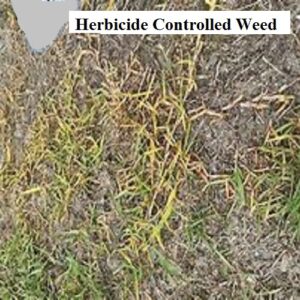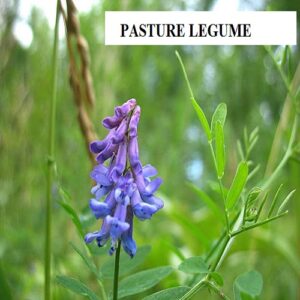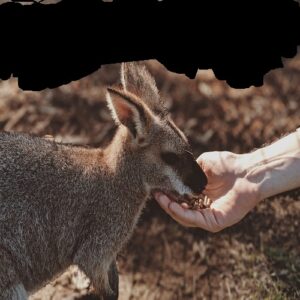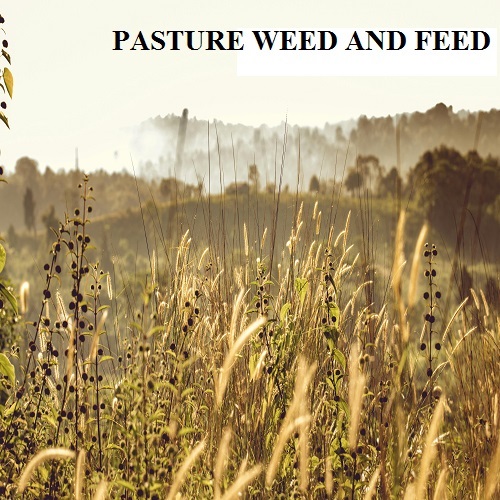Definition of Pasture Weed and Feed:
The terms pasture weed and feed are two different concepts that require proper explanation for a deeper understanding. Firstly, let’s look at the concept of a Pasture weed.
Pasture weeds are plants found growing in the pasture that are not been planted by the rancher or farmer. If a tomato plant is found growing in a pasture, the tomato plant is a weed, also if a water leave plant is found growing in the pasture, the water leave plant is a weed, no matter how it looks.
Weeds are hazardous in the pasture, if they are not removed from the pasture, the presence of weeds in the pasture can lead to a serious problem as they compete with cultivated pasture for space, moisture, air, and soil nutrients. Weeds need to be removed from the pasture regularly, mostly if they are newly cultivated.
In the newly established pasture, weeds can easily invade the new areas of land, if pre-emergence herbicides are not used to control the weeds during land preparation.
Weeds can easily infest the newly established pasture due to weed seeds attaching to the pasture planted by the ball earth method, or nicked root methods, favorable soil, and climatic factors.
For the pasture to be able to satisfy the needs of the animals, and the rancher or the livestock farmers, there is a need for effective weed control in the pasture.
Weed control in the pasture is complicated, but if they are not controlled, and allowed to grow they can easily contaminate the pasture.
Many farmers may consider Weeds as part of pastures, but weeds are different from pasture grass or legumes. Weeds can kill cultivated pastures when they have not been established.
Some weeds may develop allelopathy which is very dangerous to cultivated pasture, coupled with their ability to multiply easily and overrun the pasture within a short period.
Classification of Pasture Weeds
In the pasture, there are various species and genera of weeds, and these weeds belong to different classes. here are some of the classes of pasture Weeds according to the National Open University of Nigeria:
Grasses: these grasses belong to the family of the Poaceae, Members of this family have narrow leaf venation and adventurous root systems. Examples are Digitaria spp, Eltmus repense, Sorhum halepense, Echinclo crue gallis, and others.
Broadleaf Weeds: these pasture grasses just as their names suggest have broad leaf venation and with the tap root system. Examples are Plantago spp, Cichiorium intybus,Rumex obtusifolius, Taraxacum officinale, and others.
Woody Weeds: these are pasture woody weeds with specialized vascular bundles that can invade the pasture. This woody weed is irritating to livestock and the rancher. Examples of woody weeds are Rubus spp, Gleditsia triacanthos, Toxicosdendron radicans, Etc.
Annual Weeds: these are pasture weeds that complete their life cycle within a growing season. Examples are Digitaria spp, Echinochloa crus-galli, Tridax procumbens, Agarantum conyzoides, etc.
Perennial weeds: these are pasture weeds that complete their life cycle in more than two years. Examples are Cirsium spp, taraxacum officinale, Plantago spp, Cichorium intybus, Rumex obtusifolius. Sorghum halepense, elymus repens, etc.
Aquatic weeds: these are weeds that can easily invade pastures with waterlogged soil. Examples are Typha spp, Eichhornia crassipes, and others.
Questions People Often Ask
What are the classes of pasture weeds?
some of the classes of pasture weeds are Grass, broadleaf weeds, woody weeds, annual weeds, perennial weeds, and aquatic weeds.
Read Also Cattle Pasture Seed: Overview, Classifications, Benefits and 21 Types of Goad Pasture Seed
Effect of Pasture Weeds on Animal Health and Productivity
Pasture weeds can pose serious challenges to animal health and productivity as they compete with pasture for nutrients, moisture, and space.
Some of the effects of pasture weeds on livestock management are:
Reduce Nutritional Value of Forages: pasture weeds can grow and reproduce faster than cultivated pasture. They can establish faster than the cultivated pasture which empowers them to compete easily with forages for soil nutrients, water, and light.
This competition reduces the quality and quantities of pasture for livestock grazing. Due to the decrease in quality, the pasture may be unable to supply the required nutrients in the right quantity and proportion to the farm animal, thereby reducing growth, reproduction, and productivity.
Animals May Consume Toxic Weeds: if weeds are allowed to grow on the pasture, toxic weeds may emerge which may be harmful to livestock. Weeds such as Senecio spp and Conium spp contain alkaloids that are highly poisonous to livestock if they are eaten.
These toxic weeds can seriously affect the animals’ vital organs and systems which could lead to serious health implications for the animals.
Low Digestibility Value: some pasture weeds are less digestible to animals because of their high fiber content. Pasture with high fiber content generally has low nutrient absorption, reducing livestock feeding efficiency.
The rancher needs to stock the pasture with high-digestibility forages. Apart from low digestibility value, some weeds may pose serious digestive disorders to ruminate animals and may even irritate the animals’ gastrointestinal tract.
Selective Grazing: weed infestation in the pasture will lead to selective grazing, as the animal keeps scouting for palatable forages, this will lead to an imbalanced diet among the animals.
As the animals continue to selectively graze on pasture, this may lead to nutritional disorder in the livestock.
Reduce Pasture Seed Quality and Viability: weed infestation in the pasture may reduce pasture seed quality and viability.
Weeds can compete with pasture for nutrients, space, and moisture contents, but this competition will prevent pasture grasses and legumes from developing proper flowers and inflorescences that will aid seed development. On the other hand, weeds can reduce the viability of pasture seeds.
Weeds Serve as Hosts to Pests and Diseases: Weed infestation in the pasture can serve as a host to pest and disease attacks. Some weeds are host to certain pests and diseases, if they are allowed to grow in the pasture they can transmit diseases that will seriously affect the growth and productivity of livestock.
Serious Economic Loses to Farmers: toxic weeds in the pasture may lead to serious health problems in the livestock which may reduce fertility, weight loss, poor growth, and productivity in farm animals.
Harmful weeds in the forages may also contaminate meat and milk thereby leading to serious economic loss to farmers.
Types of Pasture Weeds
store
| s/no | Common name | Botanical name |
| 1 | Green leave | Amaranthus caudatus, Amaranthus spinosis |
| 2 | Lily | Crinum ornatum |
| 3 | Tridax | Tridax procumbens |
| 4 | Purple Nutsedge | Cyperus rotundus |
| 5 | pepo (Pumpkin) | Cucurbita maxima-C. |
| 6 | water leaf | Talium triangulare |
| 7 | Goat weed | Agarantus conyzodes |
| 8 | sorghum | Sorghum bicolor |
| 9 | crabgrass | Digitaria spp |
| 10 | Quake weeds | Elymus repens |
| 11 | Johnson grasses | Sorghum halepense |
| 12 | Barhad grasses | Echinocloa crus galis
|
Read Also: Goat Pasture Seed: Overview, Factors to Be Consider, And 15 Types of Goat Pasture Seed
Methods of Weeds Control
Weed in the pasture needs to be effectively controlled for the overall performance of the forage.
If weeds are poorly managed in the pasture, it can pose serious challenges to the animal and rancher. Some of the methods of weed control in the pasture are:
Mechanical Pasture Weed Control
This refers to the physical methods used in eliminating weeds in the pasture. Examples of mechanical pasture weed control are:
- Mowing: this involves the use of a tractor and tractor-coupled implement known as a mower to reduce the height of weeds in the pasture. It is an effective method of regenerating pasture.
- Slashing: this involves the use of a cutlass to manually reduce the height of the weeds in the pasture. This method of pasture weed management is time-consuming and involves a lot of drudgery.
- Hoeing: this involves using simple farm tools known as hoe to remove weeds from the pasture manually. It is used when the weed in the pasture is not overgrown.
Chemical Pasture Weed Control

This involves the use of herbicides to get rid of weeds from the pasture. The use of herbicide to control weeds in the pasture is very challenging, and it may depend on the types of pasture cultivated.
The rancher can use the following chemicals in the pasture.
- Pre-emergence Herbicide: pre-emergence herbicide has proven to be very effective in pasture weed management. The use of pre-emergence herbicides can suppress weed emergence until forages have developed proper roots to compete with weed.
- Selective Herbicide: selective weed killers can also effectively control pasture weed. Herbicides that are weed-specific can be used for pasture weed management. In a narrow-leaved pasture, selective herbicides can control broad weeds and vice versa.
- Systemic Herbicide (spot control): non-selective herbicides can also be used for spot control. In the pasture, due to seed failure weeds may invade such areas, and such weeds need to be removed by spot spraying. In this system of pasture control, care must be taken, so that wind will not carry herbicide to the desired pasture. The spraying should be done in the cool evening or early in the morning when the wind blow is low.
Biological Pasture Weed Control Measure
This involves the use of living organisms that are natural enemies of pasture weeds to control such weeds.
Some weeds have natural enemies that depend on them for survival such enemies can be introduced in the pasture to control such weeds.
- Use of Non-selective Grazers: ruminant animals like goats and sheep that are noon selective grazers or can also graze on large varieties of weeds can be used to control weeds in the pasture.
- Uses of Allelopathy Pasture Grass: pasture grass that can secret toxic chemicals that kill weeds, can also be effectively used to control weeds in the pasture. certain pasture grasses and legumes such as Pennisetum purpureum, Axonopus compresus, Centrosema pubescens, Pueraria phaseoloides have allelopathy tendencies to control weeds in the pasture.
Cultural Methods of Weed Control
This involves the use of cultural practices to control pasture weed height. This system is a sustainable method of weed control because it is environmentally friendly and does not harm the environment. Some of the methods used to control weed culturally are:
- Cover Cropping: the uses of cover crops such as Axonopus compresus, Mucuna pruriens, Pueraria phaseoloides, and others can serve as a good ground cover thereby smothering weed growth and development.
- Rotational grazing: The practice of rotational grazing can be effectively used to control weeds in the pasture. Implementing rotation grazing in the pasture can be used to promote the control of weeds thereby promoting the effective growth of desirable pasture grasses.
- Overseeing or Overpopulation of Pasture: overseeding or overpopulating pasture with seedlings or seeds will increase the population density of pasture grasses which will help to suffocate pasture weeds, thereby eliminating the presence of weeds in the pasture.
Question People Often Ask
What are the herbicides for pasture weed?
Some of the herbicides for the effective control of pasture weeds in the pasture are:
- touchdown IQ is a non-selective herbicide for the control of pasture weed
- 2,4-D is a selective herbicide for the control of broadleaf herbicide
- Atrazine is a non-selective herbicide for the control of grasses.
- Glyphosate is a systemic herbicide that kills most plants.
- Dicamba is a selective herbicide that is used to control broadleaf weeds
- Metribuzin is a non-selective herbicide that is used to control pasture grasses.
Integrated Approaches to Pasture Weed Control
These refer to a holistic approach to eliminating weeds from pasture. It involves the use of different weed control measures to reduce the population of weeds in the pasture.
Since weeds can multiply easily and have the ability to be established early before cultivated pasture grass.
It is advisable to think of more holistic approaches to keep weeds permanently down in the pasture. The system involves a combination of two or more methods of weed control measures to eliminate pasture weeds.
Read Also: Farm Machine Sheds: Overview, functions, types, and 9 Features of Modern Farm Machine Shed Design
Pasture Feed
It has been established earlier that the concept of pasture weed and feed will be looked into separately, we have explained the concept of pasture weed, and now we shall be looking at pasture feed.
Pasture feed is grasses or legumes generally cultivated, managed, and harvested for feeding livestock. Ruminate animals such as goats, sheep, and cattle primarily feed on grasses or legumes. these animals or pasture-fed animals usually have access to graze on pasture or pasture harvested and stored for feeding livestock.
Raising animals on pastures is considered more sustainable because the animals have access to quality pastures which in turn have influenced their growth and productivity.
The nutritional quality of an open pasture has a noticeable effect on meat and milk production ability. Animals that are reared on confined or restricted ranches may require supplementary feeds with pasture.
Pasture weeds and feed need to be carefully monitored in the pasture because weeds may affect the quality and quantities of the pasture weeds.
Nutrient-Rich Pasture Feed
Well-cultivated pasture stock with a good proportion of legumes and grasses can supply essential nutrients required for animal growth and development. Legumes in the pasture are rich in crude protein, phosphorus, calcium, and vitamins.
Grasses Nutrient Rich Pasture Feed Composition
| S/no | Common name | Botanical name | Nutrients composition |
| 1 | Elephant grass | Pennisetum purpureum | Carbohydrate, sodium, manganese, iron, copper, and zinc |
| 2 | Guninea grass | penicum maximum | Carbohydrates, manganese, iron, copper, and zinc |
| 3 | Carpet grass | Axonopus compresus | Carbohydrates, calcium, manganese, iron, and copper. |
| 4 | Barmuda grass | cynodon dactylon | Carbohydrates, calcium, manganese, Vitamin (vitamin A), phosphorus |
| 5 | Gamba grass | Andropogon gayanus | carbohydrates, potassium, sodium, manganese, iron, copper and zinc |
| 6 | Rhodes grass | Chloris gayana | carbohydrates, potassium, sodium, manganese, and zinc |
| 7 | Rhygrass | Lolium multflorum | Carbohydrates, Vitamins (vitamins A and E), and phosphorus. |
| 8 | Signal Grass | Brachiaria decumbens | Carbohydrates, sodium, manganese, iron, and copper. |
| 9 | Woolly Finger Grass | Digitaria smutsii | Carbohydrates, calcium, magnesium, potassium, sodium, and manganese, |
| 10 | Almond Blossom grass | Giliricidia sepium | carbohydrate, and sodium. |
| 11 | Carpet grass | Axonopus compresus | Carbohydrates. |
| 12 | Orchard grass | Dactylis glomerata | carbohydrate and calcium |
| 13 | Timothy grasses | Phleum pratense | carbohydrate, phosphorus, calcium, sodium, manganese, and iron. |
| 14 | Tall fescue | Festuca arundinacea | carbohydrate, Calcium, potassium, sodium, manganese, and iron. |
Questions People Often Ask
what are the best pasture seeds for pasture establishment?
Some of the best pasture seeds used for pasture establishment are Axonopus compresus, Cynodon dactylon, Andropogon gayanus, Phleum pratense (pasture grasses), and Stylosanthese glacilis, Medicago sativa,Mucuna pruriens and Trifolium spp ( pasture legumes)
Legume Nutrient Pasture Feed Composition

Some of the common legume forages and their nutrient composition are enumerated below.
| S/no | Common name | Botanical name | Nutrients composition |
| 1 | Stylo legume grass | Stylosanthese glacilis | Protein, calcium, vitamin, phosphorous, etc |
| 2 | Centro legume grass | Centrosema pubescens | Protein, calcium, vitamins (vitamins A, D, and K) phosphorous, etc. |
| 3 | Alfafa legume grass | Medicago sativa | Protein, calcium, vitamin (vitamins A, D, and K) phosphorous, Zinc, iron, etc. |
| 4 | Clover legume grass | Trifolium spp | Protein, calcium, vitamin magnesium, potassium iron, copper, and zinc (vitamins A, D, and K) phosphorous. |
| 6 | Birdsfoot trefoil grass | Lotus corniculatus | Protein, calcium, vitamins, phosphorous, magnesium, potassium, etc. |
| 7 | Vetch grass-legume | Vicia spp | Protein, calcium, vitamins, and phosphorous, etc. |
| 8 | Tropical Kudzu legume grass | Pueraria phaseoloides | Protein, calcium, vitamin, iron, copper and zinc phosphorous, etc. |
| 9 | Mucuna legume grass | Calapogonium mucunoides, Mucuna pruriens | Protein, magnesium, potassium calcium, vitamin, phosphorous, etc. |
| 10 | Pinto peanuts legume grass | Arachis pintoi | Protein, phosphorous, etc. |
Supplementary Feed in Pasture
Most of the time, pasture feed alone cannot supply all the nutrients and elements required by the livestock for growth and development.
The farmers or the rancher need to add more feeds with good nutritional value that are lacking in the pasture.
The additional feeds added or mixed with the pasture to supplement the nutrient requirement of the animals are known as supplementary feeds.
Supplementary feeds are feed added or mixed with the animal feed to make up the nutrients needed by the farm animals.
The farm animals need a balanced diet to avoid malnutrition. the animal needs supplementary feeds like protein, minerals, energy, vitamins, and a mixture of basal feeds.
Some of the supplementary feed that the rancher needs to consider for livestock in pasture-based feed are:
Types of Supplementary Feed in Pasture

The supplementary feeds that are usually used as supplements in livestock pasture, according to the University of Georgia Extension Bulletin (2023) are:
- Concentrates Feed: these are pasture feeds that are low in fibers, but rich in energy and protein. They are grain seeds that are used in combination with others to supply nutrients required to nourish or balance feed nutritionally. Examples are maize, millet, soybean, etc. The importance of concentrate as a supplementary feed in the pasture is to supplement the energy and protein level in the animal ration.
- Protein Supplements: these are supplements that contain organic compounds composed of amino acids that are normally supplied to livestock to address the protein deficiencies contents in the pasture. Examples are palm kernel cake, sunflowers, blood meal, soybean cake, etc. Pasture-fed livestock requires a high amount of protein daily for the body’s maintenance and growth, this is because the forages are sometimes limited in meeting the nutritional value of the crude protein requirement of the animals. livestock requires protein for the replacement of worn tissues, growth, milk production, and formation of reproductive gametes and as constituents of blood.
- Mineral Supplements: these are inorganic substances supplied to the animal to meet the essential mineral elements such as calcium, phosphorous, and magnesium, and other micronutrients such as zinc, and iron required by pasture-fed livestock. It comprises about 3% of the livestock body. The mineral supplement in the pasture helps to promote growth, bone and teeth formation, and prevention of disease.
- Vitamin Supplements: these are inorganic substances supplied to the animal to meet the vitamin requirement in the pasture-fed diet. however, they are required in small quantities but are essential to livestock. Examples are vitamin premix, yellow Maize, etc. Vitamins act as coenzymes that promote important chemical reactions in livestock, help in the development, and maintenance of the body cells, and are important for the cure and prevention of diseases.
- Feed additives: these are supplements added to the forage to increase their palatability and acceptability to the animals. They are also called forage enhancers because they encourage animals to consume large amounts of forage thereby promoting feed intake and proper utilization of feeds
Questions People Often Ask
what are the types of supplements for ruminant animals?
some of the types of supplements for ruminant animals are: Concentrates Feed, Vitamin Supplements, Protein Supplements, Mineral Supplements, and Feed additives
In conclusion
Pasture weeds can seriously affect pasture feed, so weeds should be continually removed from pasture, to ensure that the livestock have a high quality of pasture to feed on
